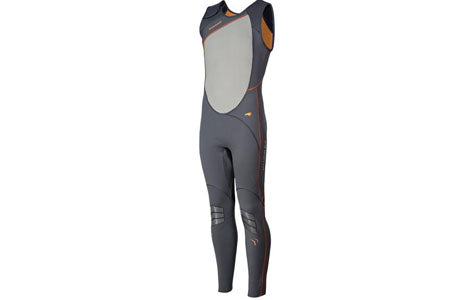Wetsuits and drysuits both have qualities which make them suited to different conditions. Read our advice for choosing the best option for your own activities.
If you are an aspiring sailor or are thinking about trying your hand at a watersport, your first priority should be to ensure you are well protected in wet conditions.
The body can retain its own heat in water at 32 degrees and above. As water can conduct heat away from the body 25 times faster than air, spending time in water colder than 32 degrees means you can become very cold, very quickly without the correct kit.
Drysuits vs Wetsuits – which is best for me?
Often, the first decision is which is best for your needs – a wetsuit or drysuit?
If you’re not sure about the answer to this yet, then we’ll highlight the features and benefits of each.
Wetsuits
Generally, wetsuits are made from neoprene which provides the body with a level of insulation. Neoprene wetsuits are available in a variety of thicknesses, which should be used in accordance with the temperature of the water you are going to be used with. At ArdMoor, we offer wetsuits of a 3mm and 5mm thickness with the former being suited to warmer waters in warmer months. The 5mm suits are better suited to winter months or cold water activities.
Wetsuits are not designed to keep you dry, instead a wet suit works by trapping a thin layer of water between your body and the suit. This film of water is then warmed by your body temperature. For this reason, it’s important that a wetsuit should be a tight fit to prevent water “flushing” through the suit as this will carry body heat away rather than keeping it trapped, increasing heat loss from your body.

In addition to different thicknesses, there are also different styles of wetsuit, your choice will largely be dictated by the weather and the temperature of the water.
In warm weather a shortie wetsuit is ideal. This keeps your body (and vital organs) insulated while leaving your arms and legs exposed.
In colder weather a full length wetsuit is advisable, in the 5mm thickness if temperatures are particularly chilly. For added insulation, a rash vest can be worn underneath or wetsuit boots, gloves and hoods can be added to protect your extremities.
Drysuits
As the name suggests, drysuits work by keeping water out and are designed to protect from extreme cold temperatures. The neck and cuffs of a dry suit feature strong seals to keep water out and keep the wearer dry and warm.
Insulating layers or a breathable fleece suit can be worn underneath a drysuit during winter months. Drysuits tend to be worn when diving in particularly cold waters or for offshore sailing and offer great freedom of movement.
As with most outdoor kit, your choice between a wetsuit or a drysuit will likely be dictated by the weather and as well as your activity of choice.
Whether you enjoy sailing or take part in watersports such as kayaking, surfing and jetskiing, you’ll find wetsuits and wet weather gear to suit your needs at ArdMoor.

